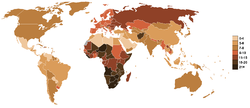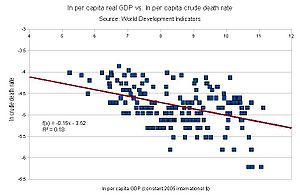- Mortality rate
-
Mortality rate is a measure of the number of deaths (in general, or due to a specific cause) in a population, scaled to the size of that population, per unit time. Mortality rate is typically expressed in units of deaths per 1000 individuals per year; thus, a mortality rate of 9.5 in a population of 100,000 would mean 950 deaths per year in that entire population, or 0.95% out of the total. It is distinct from morbidity rate, which refers to the number of individuals in poor health during a given time period (the prevalence rate) or the number of newly appearing cases of the disease per unit of time (incidence rate). The term "mortality" is also sometimes inappropriately used to refer to the number of deaths among a set of diagnosed hospital cases for a disease or injury, rather than for the general population of a country or ethnic group. This disease mortality statistic is more precisely referred to as "case fatality".
One distinguishes:
- The crude death rate, the total number of deaths per year per 1000 people. As of July 2009[update] the crude death rate for the whole world is about 8.37 per 1000 per year according to the current CIA World Factbook.[1]
- The perinatal mortality rate, the sum of neonatal deaths and fetal deaths (stillbirths) per 1000 births.
- The maternal mortality rate, the number of maternal deaths per 100,000 live births in same time period.
- The infant mortality rate, the number of deaths of children less than 1 year old per 1000 live births.
- The child mortality rate, the number of deaths of children less than 5 years old per 1000 live births.
- The standardised mortality ratio (SMR)- This represents a proportional comparison to the numbers of deaths that would have been expected if the population had been of a standard composition in terms of age, gender, etc.[2]
- The age-specific mortality rate (ASMR) - This refers to the total number of deaths per year per 1000 people of a given age (e.g. age 62 last birthday).
In regard to the success or failure of medical treatment or procedures, one would also distinguish:
- The early mortality rate, the total number of deaths in the early stages of an ongoing treatment, or in the period immediately following an acute treatment.
- The late mortality rate, the total number of deaths in the late stages of an ongoing treatment, or a significant length of time after an acute treatment.
Note that the crude death rate as defined above and applied to a whole population can give a misleading impression. The crude death rate depends on the age (and gender) specific mortality rates and the age (and gender) distribution of the population. The number of deaths per 1000 people can be higher for developed nations than in less-developed countries, despite life expectancy being higher in developed countries due to standards of health being better. This happens because developed countries typically have a completely different population age distribution, with a much higher proportion of older people, due to both lower recent birth rates and lower mortality rates. A more complete picture of mortality is given by a life table which shows the mortality rate separately for each age. A life table is necessary to give a good estimate of life expectancy.
Contents
Statistics
World historical and predicted crude death rates (1950–2050)
UN, medium variant, 2008 rev.[3]Years CDR Years CDR 1950–1955 19.5 2000–2005 8.6 1955–1960 17.3 2005–2010 8.5 1960–1965 15.5 2010–2015 8.3 1965–1970 13.2 2015–2020 8.3 1970–1975 11.4 2020–2025 8.3 1975–1980 10.7 2025–2030 8.5 1980–1985 10.3 2030–2035 8.8 1985–1990 9.7 2035–2040 9.2 1990–1995 9.4 2040–2045 9.6 1995–2000 8.9 2045–2050 10 During ancient times and the Middle Ages, the crude death rate was about 40 deaths per year per 1,000 people.[citation needed]
The ten countries with the highest crude death rate, according to the 2009 CIA World Factbook estimates, are:
Rank Country Death rate
(annual deaths/1000 persons)1  Swaziland
Swaziland30.83 2  Angola
Angola24.08 3  Lesotho
Lesotho22.20 4  Sierra Leone
Sierra Leone21.91 5  Zambia
Zambia21.34 6  Liberia
Liberia20.73 7  Mozambique
Mozambique20.07 8  Afghanistan
Afghanistan19.18 9  Djibouti
Djibouti19.10 10  Central African Republic
Central African Republic17.84 See list of countries by death rate for worldwide statistics.
According to the World Health Organization, the 10 leading causes of death in 2002 were:
- 12.6% Ischaemic heart disease
- 9.7% Cerebrovascular disease
- 6.8% Lower respiratory infections
- 4.9% HIV/AIDS
- 4.8% Chronic obstructive pulmonary disease
- 3.2% Diarrhoeal diseases
- 2.7% Tuberculosis
- 2.2% Trachea/bronchus/lung cancers
- 2.2% Malaria
- 2.1% Road traffic accidents
Causes of death vary greatly between first and third world countries. See list of causes of death by rate for worldwide statistics.
Scatter plot of the natural logarithm of the crude death rate against the natural log of per capita real GDP. The slope of the trend line is the elasticity of the crude death rate with respect to per capita real income. It indicates that a 10% increase in per capita real income is associated with a 1.5% decrease in the crude death rate. Source: World Development Indicators.
According to Jean Ziegler (the United Nations Special Rapporteur on the Right to Food for 2000 to March 2008), mortality due to malnutrition accounted for 58% of the total mortality in 2006: "In the world, approximately 62 millions people, all causes of death combined, die each year. In 2006, more than 36 millions died of hunger or diseases due to deficiencies in micronutrients".[4]
Of the roughly 150,000 people who die each day across the globe, about two thirds—100,000 per day—die of age-related causes.[5] In industrialized nations, the proportion is much higher, reaching 90%.[5]
See also
- Biodemography
- Birth rate
- Case fatality
- Compensation law of mortality
- Demography
- Egalitarian mortality
- Gompertz-Makeham law of mortality
- Life expectancy
- List of causes of death by rate
- List of countries by death rate
- Maximum life span
- Micromort
- Morbidity
- Mortality
- Mortality displacement
Notes
- ^ CIA World Factbook -- Rank Order - Death rate Search for "World".
- ^ Everitt, B.S. The Cambridge Dictionary of Statistics, CUP. ISBN 0-521-81099-X
- ^ UNdata: Crude death rate (per 1,000 population)
- ^ Jean Ziegler, L'Empire de la honte, Fayard, 2007 ISBN 978-2-253-12115-2, p.130.
- ^ a b Aubrey D.N.J, de Grey (2007). "Life Span Extension Research and Public Debate: Societal Considerations" (PDF). Studies in Ethics, Law, and Technology 1 (1, Article 5). doi:10.2202/1941-6008.1011. http://www.sens.org/files/pdf/ENHANCE-PP.pdf. Retrieved August 7, 2011.
References
- Crude death rate (per 1,000 population) based on World Population Prospects The 2008 Revision, United Nations. Retrieved 22 June 2010
- Rank Order - Death rate in CIA World Factbook
- Mortality in The Medical Dictionary, Medterms. Retrieved 22 June 2010
- "WISQARS Leading Causes of Death Reports, 1999 - 2007", US Centers for Disease Control Retrieved 22 June 2010
- Edmond Halley, An Estimate of the Degrees of the Mortality of Mankind (1693)
External links
- DeathRiskRankings: Calculates risk of dying in the next year using MicroMorts and displays risk rankings for up to 66 causes of death
- Data regarding death rates by age and cause in the United States (from Data360)
- Complex Emergency Database (CE-DAT): Mortality data from conflict-affected populations
- Human Mortality Database: Historic mortality data from developed nations
- Google - public data: Mortality in the U.S.
Biomedical research: Clinical study design / Design of experiments Overview Controlled study
(EBM I to II-1; A to B)Observational study
(EBM II-2 to II-3; B to C)Epidemiology/
methodsoccurrence: Incidence (Cumulative incidence) · Prevalence (Point prevalence, Period prevalence)
association: absolute (Absolute risk reduction, Attributable risk, Attributable risk percent) · relative (Relative risk, Odds ratio, Hazard ratio)
other: Virulence · Infectivity · Mortality rate · Morbidity · Case fatality · Specificity and sensitivity · Likelihood-ratios · Pre/post-test probabilityTrial/test types Analysis of clinical trials Risk–benefit analysis
Interpretation of results Category · Glossary · List of topics
Wikimedia Foundation. 2010.


